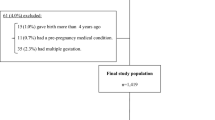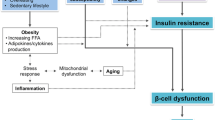Abstract
Introduction
We investigated whether changes in interpregnancy body mass index (BMI) influence the risk of gestational and type 2 diabetes among a cohort of women with two consecutive live, singleton births of 20–44 weeks gestation (n = 232,272).
Methods
Logistic regression models were used to examine the risk for development of gestational or type 2 diabetes during the second pregnancy. Mothers with normal weight for both pregnancies (normal-normal) served as the referent group.
Results
Across all BMI categories, mothers with significant weight gain (i.e., moving from a lower BMI category into a higher category) had an increased risk for the development of diabetes. Mothers who moved from normal prepregnancy weight (BMI = 18.5–24.9 kg/m2) in the first pregnancy to obese prepregnancy weight (BMI ≥ 30.0 kg/m2) in the second pregnancy showed the greatest increment in risk. These mothers exhibited a threefold risk for developing diabetes (OR = 3.21, 95% CI 2.76–3.73). Mothers who maintained their interpregnancy BMI weight category or who moved to a lower BMI category had reduced risk for gestational and type 2 diabetes. The risk associated with mothers who moved to a lower BMI category was approximately half that of the normal-normal BMI category.
Conclusion
Interpregnancy weight gain is associated with a dose–response increase in risk of diabetes. Establishing a normal interpregnancy BMI may reduce the risk of diabetes.
Similar content being viewed by others
References
Huda SS, Brodie LE, Sattar N (2010) Obesity in pregnancy: prevalence and metabolic consequences. Semin Fetal Neonatal Med 15:70–76
Catalano PM, Ehrenberg HM (2006) The short-and long-term implications of maternal obesity on the mother and her offspring. BJOG 113:1126–1133
Kabiru W, Raynor BD (2004) Obstetric outcomes associated with increase in BMI category during pregnancy. Am J Obstet Gynecol 191:928–932
Sathyapalan T, Mellor D, Atkin SL (2010) Obesity and gestational diabetes. Semin Fetal Neonatal Med 15:89–93
Athukorala C, Rumbold AR, Willson KJ, Crowther CA (2010) The risk of adverse pregnancy outcomes in women who are overweight or obese. BMC Pregnancy Childbirth 10:56
Rees M, Karoshi M, Keith L (2008) Obesity and pregnancy. Royal Society of Medicine Press, United Kingdom
Hauger MS, Gibbons L, Vik T, Belizán JM (2008) Prepregnancy weight status and the risk of adverse pregnancy outcome. Acta Obstet Gynecol Scand 87:953–959
Torloni MR, Betrán AP, Horta BL, Nakamura MU, Atallah AN, Moron AF, Valente O (2009) Prepregnancy BMI and the risk of gestational diabetes: a systematic review of the literature with meta-analysis. Obes Rev 10:194–203
Villamor E, Cnattingius S (2006) Interpregnancy weight change and risk of adverse pregnancy outcomes: a population-based study. Lancet 368:1164–1170
Herman AA, McCarthy BJ, Bakewell JM, Ward RH, Mueller BA, Maconochie NE, Read AW, Zadka P, Skjaerven R (1997) Data linkage methods used in maternally-linked birth and infant death surveillance data sets from the United States (Georgia, Missouri, Utah and Washington State), Israel, Norway, Scotland and Western Australia. Paediatr Perinat Epidemiol 11:5–22
Martin J, Curtin S, Saulnier M, Mousavi J (2003). Development of the matched multiple birth file. In: 1995–1998 matched multiple birth dataset. NCHS CD-ROM series 21, no. 13a. National Center for Health Statistics, Hyattsville
Herman AA, Yu KF (1997) Adolescent age at first pregnancy and subsequent obesity. Paediatr Perinat Epidemiol 11:130–141
WHO (2000). Obesity: preventing and managing the global epidemic. Report of a WHO Consultation. WHO Technical Report Series 894. World Health Organization, Geneva
Rasmussen KM, Catalano PM, Yaktine AL (2009) New guidelines for weight gain during pregnancy: what obstetrician/gynecologists should know. Curr Opin Obstet Gynecol 21:521–526
Al-Jasmi F, Al-Mansoor F, Alsheiba A, Carter AO, Carter TP, Hossain MM (2002) Effect of interpregnancy interval on risk of spontaneous preterm birth in Emirati women, United Arab Emirates. Bull World Health Organ 80:871–875
Alexander GR, Kotelchuck M (1996) Quantifying the adequacy of prenatal care: a comparison of indices. Public Health Rep 3:408–418
Alexander GR, Cornely DA (1987) Prenatal care utilization: its measurement and relationship to pregnancy outcome. Am J Prevent Med 3:243–253
Colditz GA, Willett WC, Stampfer MJ, Manson JE, Hennekens CH, Arky RA, Speizer FE (1990) Weight as a risk factor for clinical diabetes in women. Am J Epidemiol 132:501–513
Dennedy MC, Dunne F (2010) The maternal and fetal impacts of obesity and gestational diabetes on pregnancy outcome. Best Pract Res Clin Endocrinol Metab 24:573–589
Catalano PM, Huston L, Amini SB, Kalhan SC (1999) Longitudinal changes in glucose metabolism during pregnancy in obese women with normal glucose tolerance and gestational diabetes mellitus. Am J Obstet Gynecol 180:903–916
Catalano PM, Tyzbir ED, Wolfe RR, Roman NM, Amini SB, Sims EA (1992) Longitudinal changes in basal hepatic glucose production and suppression during insulin infusion in normal pregnant women. Am J Obstet Gynecol 167:913–919
Catalano PM, Vargo KM, Bernstein IM, Amini SB (1991) Incidence and risk factors associated with abnormal postpartum glucose tolerance in women with gestational diabetes. Am J Obstet Gynecol 165:914–919
Rooney BL, Schauberger CW, Mathiason MA (2005) Impact of perinatal weight change on long-term obesity and obesity-related illnesses. Obstet Gynecol 106:1349–1356
Vesco KK, Dietz PM, Rizzo J, Stevens VJ, Perrin NA, Bachman DJ, Callaghan WM, Bruce FC, Hornbrook MC (2009) Excessive gestational weight gain and postpartum weight retention among obese women. Obstet Gynecol 114:1069–1075
McKeown T, Record RG (1957) The influence of weight and height on weight changes associated with pregnancy in women. J Endocrinol 15:423–429
Olson CM, Strawderman MS, Hinton PS, Pearson TA (2003) Gestational weight gain and postpartum behaviors associated with weight change from early pregnancy to 1 y postpartum. Int J Obes Relat Metab Disord 27:117–127
Keppel KG, Taffel SM (1993) Pregnancy-related weight gain and retention: implications of the 1990 Institute of Medicine guidelines. Am J Public Health 83:1100–1103
Gunderson EP, Abrams B (1999) Epidemiology of gestational weight gain and body weight changes after pregnancy. Epidemiol Rev 21:261–275
Boardley DJ, Sargent RG, Coker AL, Hussey JR, Sharpe PA (1995) The relationship between diet, activity, and other factors, and postpartum weight change by race. Obstet Gynecol 86:834–838
Muscati SK, Gray-Donald K, Koski KG (1996) Timing of weight gain during pregnancy: promoting fetal growth and minimizing maternal weight retention. Int J Obes Relat Metab Disord 20:526–532
Scholl TO, Hediger ML, Schall JI, Ances IG, Smith WK (1995) Gestational weight gain, pregnancy outcome, and postpartum weight retention. Obstet Gynecol 86:423–427
Parker JD, Abrams B (1993) Differences in postpartum weight retention between black and white mothers. Obstet Gynecol 81:768–774
Rooney BL, Schauberger CW (2002) Excess pregnancy weight gain and long-term obesity: one decade later. Obstet Gynecol 100:245–252
Niedhammer I, Bugel I, Bonenfant S, Goldberg M, Leclerc A (2000) Validity of self-reported weight and height in the French GAZEL cohort. Int J Obes Relat Metab Disord 24:1111–1118
Fattah C, Farah N, O’Toole F, Barry S, Stuart B, Turner MJ (2009) Body Mass Index (BMI) in women booking for antenatal care: comparison between selfreported and digital measurements. Eur J Obstet Gynecol Reprod Biol 144:32–34
Conflict of interest
None.
Author information
Authors and Affiliations
Corresponding author
Rights and permissions
About this article
Cite this article
Whiteman, V.E., Aliyu, M.H., August, E.M. et al. Changes in prepregnancy body mass index between pregnancies and risk of gestational and type 2 diabetes. Arch Gynecol Obstet 284, 235–240 (2011). https://doi.org/10.1007/s00404-011-1917-7
Received:
Accepted:
Published:
Issue Date:
DOI: https://doi.org/10.1007/s00404-011-1917-7




